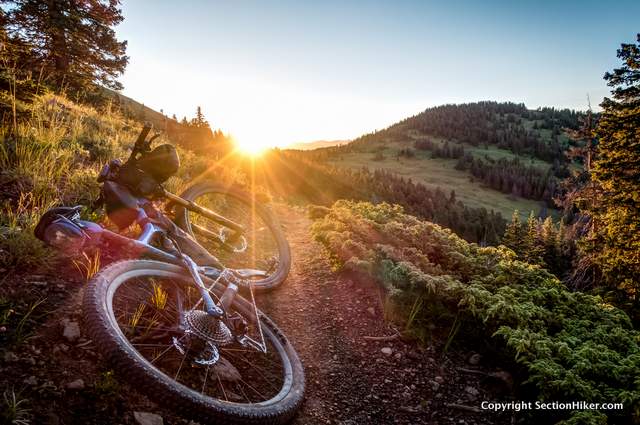Bikepacking, essentially backpacking with a bike, is a great way to explore backcountry destinations that can’t be reached by hiking trails or are closed to cars and trucks.
Want to climb a remote peak that no one’s climbed? Photograph wild animals in their natural habitat? Or discover a wild trout stream that’s never been fished? Just hop on your mountain bike, pack up your overnight gear, and ride into the sunset down the gated forest service roads, fire roads, logging roads, and ski mobile trails that crisscross the backcountry.
It’s as easy as riding a bicycle. Well almost…

Bikepacking Basics
Best backpacking bikes
While you can bikepack with a road bike on paved roads, a mountain bike is your best bet for riding dirt or gravel roads in the backcountry. There are a wide variety of mountain bikes available… hardtails, fat tire bikes, gravel bikes, etc. When getting started, choose a bike that you can afford and ride frequently near your home. You can always upgrade later when you have a better appreciation for the terrain and features you prefer.
If you’re not a mountain bike expert, I’d encourage you to develop a relationship with a bike store that is focused on mountain biking and buy a bike from them instead of over the internet. They’ll help you get a good fit, help you outfit your bike, and can teach you basic bike repair and maintenance skills which will make you self-sufficient and save you time getting into the sport.
Saddle time
If you’ve never mountain biked before, saddle time is important. Bike maneuverability skills on rougher terrain take practice to learn and it’s important to get in shape before you start taking any backcountry trips.
Riding a mountain bike all day instead of shorter rides can put a lot of strain on your body, so make sure to tune your bike’s fit properly before you start taking all day trips. Getting a padded seat, adjusting your seat height and stem distance, using padded grips, and repositioning your brake and shift levers, etc. – can reduce wrist strain and bum discomfort on long rides.
Bikepacking repair
Learning how to fix your own flat tires is a must and you’ll want to build a bikepacking repair kit so you don’t have to push your bike out of the backcountry on foot if it breaks down. Check with your local bike shop. They may offer a repair and maintenance course to help you up the learning curve. Learn by doing. Ride with other mountain bikers and take an experienced friend on bikepacking trips before heading out on your own.
Bikepacking Gear
Bags and Packs
While you can carry all of your bikepacking gear in a backpack, you’ll be a lot more comfortable if you pack it in stuff sacks or pockets attached to the bike frame itself. There are a wide variety of bikepacking bags and pockets available for stowing your gear on a bike including, but not limited to:
- Saddle and seat bags that attach to your rear seat post or bicycle seat
- Handlebar bags that hang above your front wheel
- Frame bags that hang below your top tube
- Gas tanks that attach on top of your top tube
There are no limits to the ways that people use to attach gear to their bikes. There’s also a burgeoning cottage industry of small manufacturers that are constantly inventing new products in the space, much like those that help spearhead the ultralight backpacking industry. Some notables are Relevate Designs, Portland Design Works, Wingnut, Oveja Negra, Arkel, Apidura, and Bedrock Gear, but there are many others.
But before you go overboard and spend a lot of money on bikepacking bags, get yourself some straps and experiment with lashing waterproof backpacking stuff sacks to your handlebars and frame. Low-tech, low-cost solutions exist for carrying gear on bikes that can save you a lot of coin. Use your imagination and save.

Ultralight and Lightweight Backpacking Gear
If you already own ultralight and lightweight backpacking gear, you’ve got a huge leg up on mountain bikers who want to break into the sport. In addition to weight, the volume or bulkiness of your gear becomes increasingly important on a bike because packing space is at such a premium. Small shelters like tarps or bivy sacks pack up smaller than tents, going stoveless or using a wood stove can save valuable pack space, using a quilt instead of a sleeping bag…these are all variables that you’ll want to consider when bikepacking and may help you further refine your backpacking gear and skill set.
Wilderness Navigation Tools
Planning and navigation can also be quite challenging and fun depending on where you decide to bikepack. While knowing how to use a map and compass is still essential, it’s often easier to use a smartphone navigation app like Gaia when bikepacking because the roads you’re traveling on twist and turn so frequently. Upfront planning can also be a huge challenge, depending on how well-mapped the area you plan to travel is. Learning how to use a planning tool with satellite photos, can be a big help in discovering new backcountry roads to travel or where existing roads are.
Bikepacking and Backpackers
Bikepacking is a great way to explore new terrain for backpackers that lets you use much of the same camping gear and navigation skills you use on the trail. There’s no reason you can’t combine the two into multi-modal adventures where you bike and hike more remote peaks, camp at seldom-visited destinations, or fly fish small streams and headwaters. Bikepacking provides a great way to push back the boundaries of time and distance and experience the wilderness more deeply.
Have you taken the bikepacking plunge?
SectionHiker is reader-supported. We only make money if you purchase a product through our affiliate links. Help us continue to test and write unsponsored and independent gear reviews, beginner FAQs, and free hiking guides.
